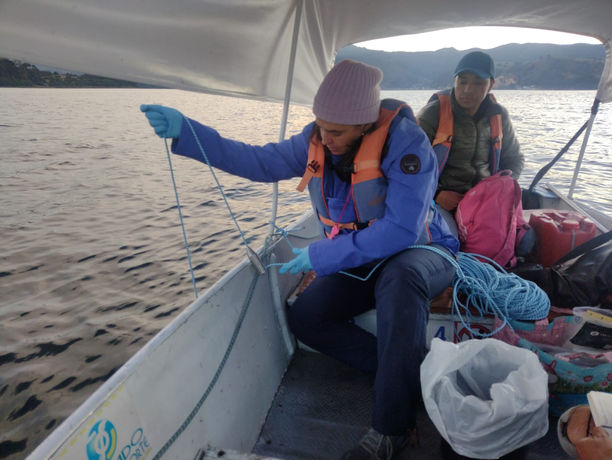What is environmental DNA ?
What we are talking about when we talk about environmental DNA. All living organisms leave traces of their genetic material (DNA) as they move through the world. This is how their DNA ends up in the environment, in water, air or soil. It can come from their skin, excretions or wounds.
Currently, scientific advances in the field of molecular biology allow us to take and filter this material (for example, by filtering water) and then, using the PCR technique (polymerase chain reaction), copy in sequence some regions of the genome thousands of times. It is there that these sequences are compared with databases that allow us to
identify the species that left their genetic material behind.
It's an amazing technique, which allows us to identify organisms without having to see them! It can be done by many people, not just scientists, and it goes beyond just being in a lab.
Sun in winter, snow in summer
In this project we investigate the migratory connection of humpback whales (Megaptera novaeangliae) between their breeding areas in the Colombian Pacific and their feeding areas in the Antarctic Peninsula. We do this by means of photo-identification and genetic analysis to understand their population dynamics and demographic changes over the years.
Partners
Coquí Community (Community Councils), Hurtigruten Expeditions, Hurtigruten Foundation
Aim
Study the population of humpback whales that breed on the Colombian Pacific coast and feed on the Antarctic Peninsula using DNA analysis techniques (genetic characterization) to monitor their anual presence, movements and behavior.
Relevance
Contribute to the understanding and conservation of these majestic creatures, helping to take measures for their protection based on the generation of scientific data.

Answers in a drop of water
Answers in a drop of water: We deepen our knowledge of the population structure of the Tucuxi dolphin (Sotalia fluviatilis) through environmental DNA analysis, in order to expand knowledge of the genetic diversity of this species in the Amazon River basin.
Partners
Dolphin Quest, Puerto Rico Manatee Conservation Center, IUCN cetacean specialist group.
Aim
To understand the genetic diversity of Tucuxi dolphins in the Amazon basin through environmental DNA analysis.
Relevance
We sought to test the potential use of environmental DNA analysis as a tool to analyze the genetic diversity and
population structure of the Tucuxi, one of the smallest dolphin species in the world, one of the most difficult to
study and one of those that most require scientific information for their conservation programs.

Great-grandmothers, grandmothers and mothers
Here we investigate the maternal lineages and genetic
diversity of hawksbill turtles (Eretmochelys imbricata) in the colombian caribbean. Contributing to the knowledge of this species to generate data that complement their conservation programs.
Partners
Rosario Islands Oceanarium-CEINER.
Aim
investigate the genetic diversity and the relationship between the populations of hawksbill turtles of the Colombian Caribbean with the populations of other places in the world.
Relevance
We work to contribute to the knowledge of this species by generating data that promotes its conservation programs.


In search of the Totas fat catfish:
In order to confirm whether the species still exists in the Tota Lagoon and surrounding areas, we carried out this research project. This species has been considered extinct since the late 1950s, but information on the possible presence of the fatty fish motivates efforts to conserve biodiversity in high mountain aquatic ecosystems.
Partners
“Alexander von Humboldt” Biological Resources Research Institute, Rewild, Shoal, Corpoboyacá, NatureMetrics.
Aim
To identify the presence of this catfish (Rhizosomichthys totae) in the Tota Lagoon through environmental DNA
analysis, in order to confirm its existence and support conservation programs for aquatic ecosystems in the Andean region.
Relevance
We want to know if the species still exists in the Tota lagoon and surrounding areas, which is why we are promoting
this research project.
Citizen science in the Antarctic Peninsula:
In this project we identify marine vertebrate communities, based on environmental DNA analysis in the Antarctic
Peninsula.
Partners
Hurtigruten Expeditions and Hurtigruten Foundation.
Aim
Involve tourists on Hurtigruten Expeditions cruise ships in the process of collecting environmental DNA samples to identify species of marine vertebrates that are part of the fauna community around the Antarctic Peninsula.
Relevance
Contribute to the knowledge of marine vertebrate communities in the Antarctic Peninsula, promoting the conservation of the last pristine corner of the planet, as well as training ship passengers in the application and use of this technique.

Citizen Science
Citizen science involves the active participation of non-professional citizens in scientific activities, from data collection to analysis and interpretation of results. This collaboration between scientists and the community not only greatly expands the amount of available data, but also fosters greater public awareness of science and the environment, thus strengthening the relationship between society and scientific research.
Support!
Our beautiful fabric keychains, bags and pencil cases with motifs of the biodiversity of Chocó and the Amazon are handmade by talented seamstresses from the region, in order to preserve the local artisan tradition and provide economic opportunities to their communities and the scientific research that seeks to preserve them. their ecosystems.
Join us in this joint effort for a more supportive and sustainable world!

































